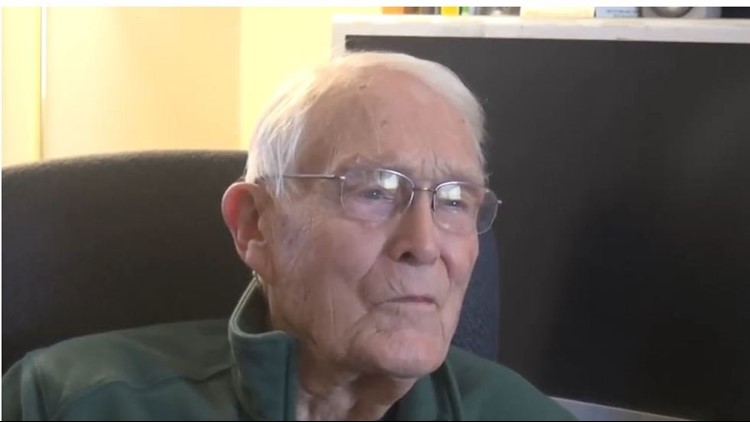Flipping through the pages of a dusty, yellowing paperback in his office, Professor James “Jim” Short, Jr., pointed to a black-and-white photograph.
“That's on the westside (of Chicago),” the 94-year-old gang researcher said as he pointed out several well-dressed figures in the photo. “That's where the Vice Lords were located.”
The photo depicts several young men walking their dogs down a bustling street, all members of one of the many street gangs Short studied in the 1950s and 1960s. His research, half a century after his historic study on the rise of supergangs like the Vice Lords, is still impacting sociology today.
Now, as a professor emeritus at Washington State University, Short remains as interested as ever.
“That’s why I became a sociologist,” he said. “I was curious about the world around me.”
Andrew Papachristos, a professor at Northwestern University and director of The Policy Lab at Yale University, called Short a legend in his field and said his work was some of the most important gang research ever. At a meeting of sociologists a decade ago, Short regaled Papachristos and others with stories from his pioneering research.
“Jim fascinated them all with stories of some of the old (old) gang leaders—legends, really whom he knew,” Papachristos wrote in an email. “Our friendship has sort of kept going from there.”
Short said he hasn’t taught an undergraduate class in years but enjoys exploring research subjects with graduate students and collaborating with colleagues. He continues his research from an office in a building that bears his name.
“I don’t know if there’s any other reason to be a college professor,” he said, “if you don’t have that intellectual curiosity.”
Short credits his time in the Marines toward the end of Word War II for expanding his worldview after his childhood in New Berlin, a small town in central Illinois. He enlisted as a college freshman, around 1945. After training, he was scheduled to join the Second Marine Division and awaited shipment to join the planned invasion of Japan, when the war ended.
“In that sense, I'm one of the luckiest guys who ever lived,” Short said, “because the Second Marine Division was scheduled for a 100 percent casualty in the first 30 days of the invasion of Japan.”
He then lived in Japan for almost a year, an experience that gave him sociological insight. After he was discharged from the military and completed his graduate degree at the University of Chicago, Short and his wife moved to WSU for a one-year position in 1951. He never left and his research has never stopped.
He is currently working with Lorrine Hughes, an associate professor at the University of Colorado Denver, to analyze the historic qualitative data he and his team originally gathered in the 1960s. The social sciences move far slower than biological sciences, he added, and often historic data will be continuously analyzed for years.
Hughes said one of Short’s biggest contributions to both gang research and the field of sociology is his approach to group processes, which explores how organizations work together.
“It was the most comprehensive study,” said Hughes. “(Short) found evidence inconsistent with dominant theories of the time and that's how this group processes perspective emerged.”
Short’s original study examined Chicago gangs and how racial divides and other factors led to violence. Short said they also witnessed some of the cultural forces that led smaller gangs, such as the Clovers and the Imperial Chaplains to come together and strengthen larger gangs such as the Vice Lords. What set the study apart, however, was their method.
It combined graduate student observers with embedded workers who were invested in helping hundreds of boys in about two-dozen gangs.
Hughes, who used the criminology research in her doctoral dissertation, recalled when she first ran into Short’s research, as paper copies in the attic of Wilson Short Hall. The dozens of boxes, which she digitized over about a decade, would eventually become the foundation of one of her most productive academic collaborations, the study of delinquent behavior.
She said there remains still a great deal of information to mine from those studies that applies to current affairs. Despite new ways to process information, she doesn’t believe studies of the scale of Short’s work are possible with the way research is conducted today.
“It's an incredible study,” Hughes said. “I think we'd be lucky to replicate it. It would take just a ton of money, and resources, and I just don't see that happening. You could do that with one or two gangs today, but the scope of it was just massive.”
Short said he still enjoys many aspects of sociology, including collaborating with researchers in other fields. The pursuit of new knowledge and illuminating history, he added, has always been his greatest passion.
Over the years, he said, colleagues have asked him to take a political stance or propose solutions to serious social issues based on the findings in his research, but he has never seen that as his role.
“That’s not how a sociologist approaches a problem,” Short said. “I’ve never been so bold to say you should do this, you should do that. Other people argue about that and figure it out. I’m just trying to understand myself and by doing so, maybe I can help other people understand as well.”
Video: Shannon Heckt



